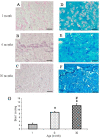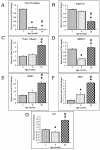Characterization of the age-dependent intervertebral disc changes in rabbit by correlation between MRI, histology and gene expression
- PMID: 21726455
- PMCID: PMC3150337
- DOI: 10.1186/1471-2474-12-147
Characterization of the age-dependent intervertebral disc changes in rabbit by correlation between MRI, histology and gene expression
Abstract
Background: The present study was conducted to address whether the intervertebral disc of rabbit could be considered (i) as a valuable model to provide new insights into the tissue and cellular changes of Nucleus pulposus aging and (ii) as an appropriate tool to investigate the efficacy of Nucleus pulposus cell-based biotherapies.
Methods: Lumbar intervertebral disc from rabbits with increasing ages (1, 6 and 30 month-old) were compared by MRI and histological observation using Pfirrmann's grading and Boos' scoring respectively. The expression of transcripts (COL2A1, AGC1, COL1A1, MMP13, BMP2, MGP and p21) in Nucleus pulposus cells were analysed by quantitative real-time PCR.
Results: MRI analysis indicated an early age-dependent increase in the Pfirrmann's grading. Histological Boos' scoring was also increased. The analysis of transcript expression levels showed that COL2A1 and AGC1 were down-regulated as a function of age. Conversely, COL1A1, MMP-13, BMP-2, MGP and p21 were significantly up-regulated in the Nucleus pulposus cells of aged rabbit intervertebral disc.
Conclusions: Our study describes the consistency of the rabbit as a model of intervertebral disc changes as a function of age by correlating tissue alteration with cellular modification measured.
Figures



Similar articles
-
Laser-treated Nucleus pulposus as an innovative model of intervertebral disc degeneration.Exp Biol Med (Maywood). 2012 Nov;237(11):1359-67. doi: 10.1258/ebm.2012.012049. Exp Biol Med (Maywood). 2012. PMID: 23239447
-
Characterization of intervertebral disc aging: longitudinal analysis of a rabbit model by magnetic resonance imaging, histology, and gene expression.Spine (Phila Pa 1976). 2008 Aug 1;33(17):1821-8. doi: 10.1097/BRS.0b013e31817e2ce3. Spine (Phila Pa 1976). 2008. PMID: 18670334
-
Transplantation of gene-modified nucleus pulposus cells reverses rabbit intervertebral disc degeneration.Chin Med J (Engl). 2011 Aug;124(16):2431-7. Chin Med J (Engl). 2011. PMID: 21933582
-
Pharmacological enhancement of disc diffusion and differentiation of healthy, ageing and degenerated discs : Results from in-vivo serial post-contrast MRI studies in 365 human lumbar discs.Eur Spine J. 2008 May;17(5):626-43. doi: 10.1007/s00586-008-0645-6. Epub 2008 Mar 21. Eur Spine J. 2008. PMID: 18357472 Free PMC article.
-
The role of proteoglycans in aging, degeneration and repair of the intervertebral disc.Biochem Soc Trans. 2002 Nov;30(Pt 6):869-74. doi: 10.1042/bst0300869. Biochem Soc Trans. 2002. PMID: 12440935 Review.
Cited by
-
Intervertebral disk width in dogs with and without clinical signs of disk associated cervical spondylomyelopathy.BMC Vet Res. 2012 Jul 28;8:126. doi: 10.1186/1746-6148-8-126. BMC Vet Res. 2012. PMID: 22839697 Free PMC article.
-
Mechanobiology of MicroRNAs in Intervertebral Disk Degeneration.J Spine Res Surg. 2023;5(1):1-9. doi: 10.26502/fjsrs0051. Epub 2023 Jan 17. J Spine Res Surg. 2023. PMID: 36777190 Free PMC article.
-
Guided bone regeneration using a bone tissue engineering complex consisting of a poly-dl-lactide membrane and bone mesenchymal stem cells.Oncotarget. 2017 Dec 22;9(23):16380-16388. doi: 10.18632/oncotarget.23594. eCollection 2018 Mar 27. Oncotarget. 2017. PMID: 29662652 Free PMC article.
-
Differences in calcification and osteogenic potential of herniated discs according to the severity of degeneration based on Pfirrmann grade: a cross-sectional study.BMC Musculoskelet Disord. 2016 Apr 29;17:191. doi: 10.1186/s12891-016-1015-x. BMC Musculoskelet Disord. 2016. PMID: 27495942 Free PMC article.
-
MicroRNA in intervertebral disc degeneration.Cell Prolif. 2015 Jun;48(3):278-83. doi: 10.1111/cpr.12180. Epub 2015 Mar 4. Cell Prolif. 2015. PMID: 25736871 Free PMC article. Review.
References
Publication types
MeSH terms
Substances
LinkOut - more resources
Full Text Sources
Medical
Miscellaneous

